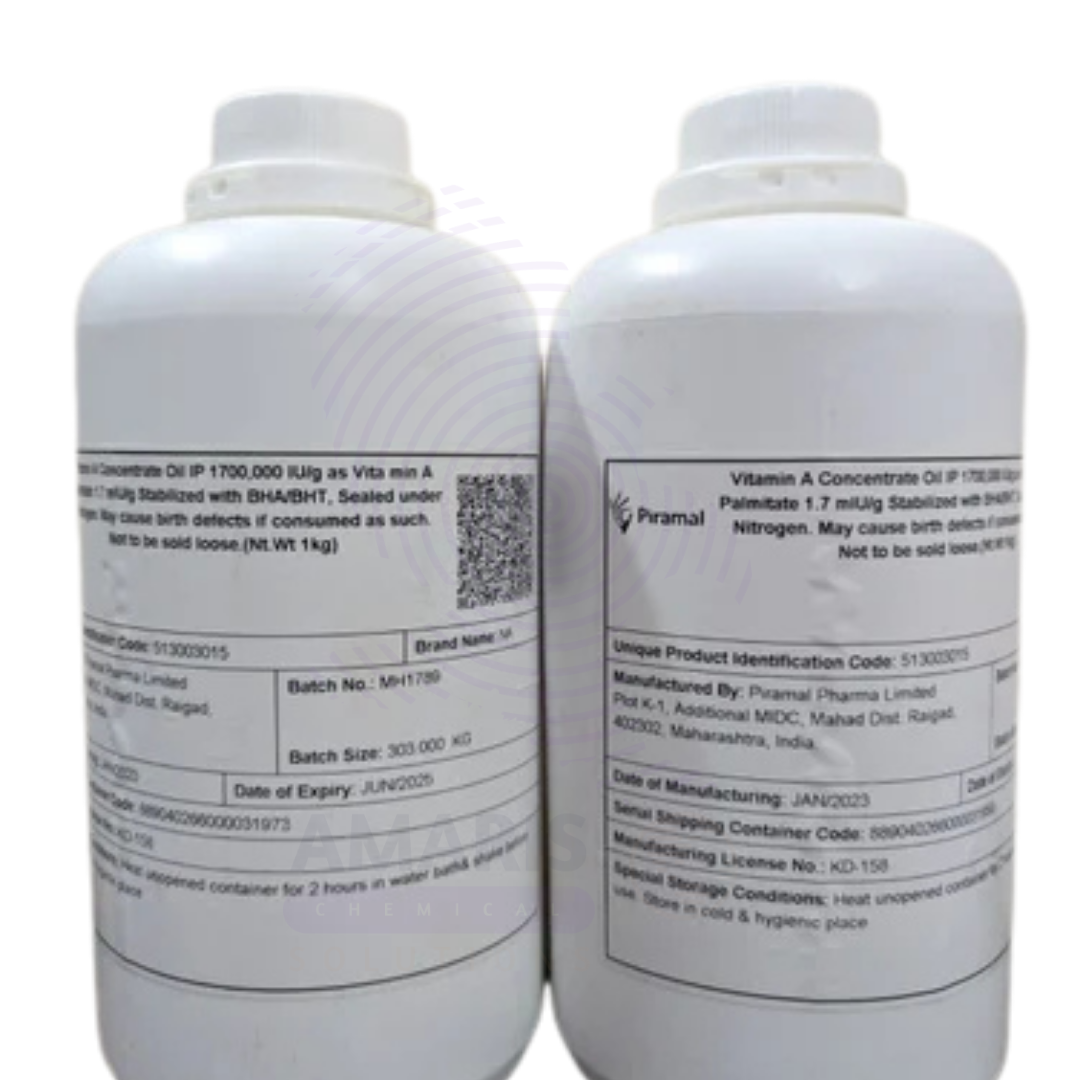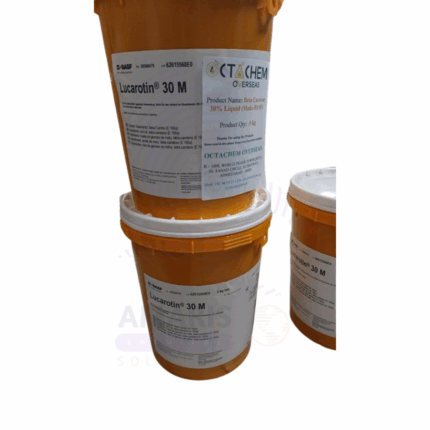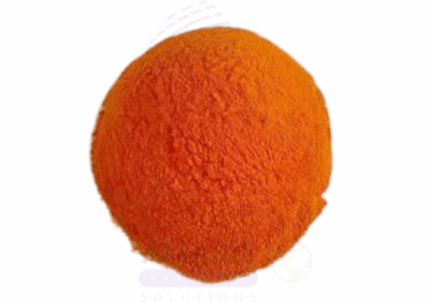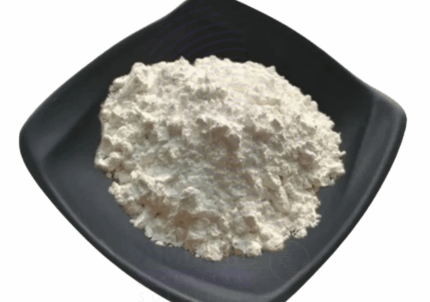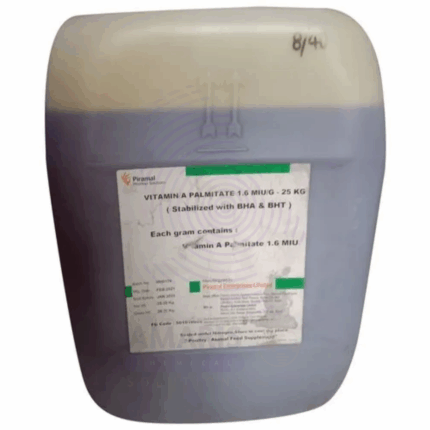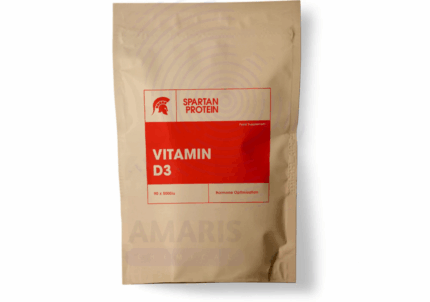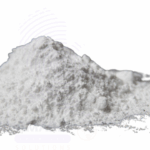

Powdered Vitamin A Palmitate Extra Pure
$ 17.25 Original price was: $ 17.25.$ 17.12Current price is: $ 17.12.
Powdered Vitamin A Palmitate Extra Pure is a stabilized form of Vitamin A in fine powder form, offering excellent bioavailability and long shelf life. This compound is widely used in nutritional supplements, fortified foods, and cosmetics for its essential role in supporting vision, immune health, and skin regeneration. Its extra pure grade makes it highly suitable for precise formulation in pharmaceuticals and research-grade preparations. Additionally, it’s favored in cosmetic formulations for anti-aging and skin-repair treatments due to its potent antioxidant and cell-regenerative properties.
Powdered Vitamin A Palmitate Extra Pure
PRIMARY USES
- Nutritional Supplements
- Used as a source of Vitamin A in dietary supplements and fortified foods.
- Essential for vision, immune function, skin health, and reproduction.
- Commonly added to infant formulas, milk powders, cereals, and multivitamin blends.
- Pharmaceutical Applications
- Incorporated into topical ointments and capsules for treating Vitamin A deficiency.
- Aids in epithelial tissue repair, and may be used in dermatological preparations for acne or skin rejuvenation.
SECONDARY USES
- Cosmetic & Skincare Formulations
- Used in anti-aging creams, serums, and lotions for its role in promoting cell turnover and collagen synthesis.
- Acts as a skin conditioning agent with antioxidant properties.
- Animal Feed Fortification
- Included in premixes for livestock and poultry to ensure proper growth, immune defense, and reproduction.
- Research & Laboratory Use
- Applied in biochemical studies involving fat-soluble vitamin metabolism or antioxidant behavior.
1. Basic Identification Attributes
- Chemical Name: Retinyl Palmitate (Vitamin A Palmitate)
- CAS Number: 79-81-2
- HS Code: 2936.10.00
- Molecular Formula: C₃₆H₆₀O₂
- Synonyms:
- Retinol palmitate
- All-trans-retinyl palmitate
- Vitamin A ester
- Retinol hexadecanoate
2. Physical & Chemical Properties
- Physical State: Powder (commonly mixed with carriers like starch or gelatin for stability)
- Color & Odor: Yellow to yellow-orange; mild odor
- Boiling Point & Melting Point:
- Melting Point: ~28–30 °C (pure ester)
- Boiling Point: Decomposes before boiling
- Density/Specific Gravity: ~0.94–0.97 g/cm³ (oil form); varies when powdered with carriers
- Solubility:
- Insoluble in water
- Soluble in fats and organic solvents (e.g., ethanol, chloroform)
- pH Level: Not applicable (non-aqueous compound)
- Vapor Pressure & Volatility: Very low volatility
- Flash Point: >100 °C (typically for oil form)
- Autoignition Temperature: Not readily available
- Viscosity: Not applicable in powder form
3. Safety & Hazard Attributes
- Hazard Class (GHS Classification):
- Not classified as hazardous under GHS for normal handling
- May cause mild skin or eye irritation in dust form
- NFPA Ratings:
- Health: 1
- Flammability: 1
- Reactivity: 0
- Exposure Limits:
- No established OSHA/ACGIH limits for retinyl palmitate
- General good hygiene practices advised
- Reactivity:
- Stable under normal storage
- Sensitive to light, air, and heat (oxidizes easily)
4. Storage & Handling Attributes
- Storage Conditions:
- Store in airtight, light-resistant containers
- Cool, dry, dark place (preferably below 25°C)
- Incompatible Materials:
- Oxidizing agents, acids, bases
- Container Type:
- Amber glass or HDPE container with oxygen barriers
- Shelf Life & Expiration Date:
- Typically 12–24 months if properly stored
- Special Handling Requirements:
- Use gloves, avoid inhaling dust
- Minimize exposure to light and oxygen
5. Regulatory & Compliance Attributes
- Regulatory Status:
- Approved by FDA (as GRAS) for food and supplement use
- Listed in REACH, TSCA, EFSA, and other chemical inventories
- Hazard Symbols (GHS Pictograms):
- None required under typical usage
- Transportation Restrictions:
- Not classified as hazardous for transport
- Waste Disposal Method:
- Dispose of according to local regulations
- Avoid release into drains or natural waters
6. Environmental & Health Impact
- Ecotoxicity:
- Low environmental impact in normal quantities
- Degrades with sunlight and microbial activity
- Persistence in Environment:
- Biodegradable but photo-sensitive
- Carcinogenicity/Mutagenicity:
- Not classified as carcinogenic
- High doses may cause toxicity (hypervitaminosis A) in humans
- Biodegradability:
- Readily biodegradable under normal environmental conditions
SAFETY PRECAUTIONS
Personal Protective Equipment (PPE):
- Laboratory coat or chemical-resistant clothing
- Nitrile gloves (check for integrity before use)
- Safety goggles or face shield
- Dust mask or particulate respirator if airborne powder is present
Handling:
- Handle in a well-ventilated area
- Avoid breathing dust and prevent contact with skin, eyes, and clothing
- Minimize dust generation and accumulation
- Use tools to avoid direct contact
- Practice good hygiene — wash thoroughly after handling
Storage:
- Store in a cool, dry, dark place away from heat and light
- Keep container tightly closed
- Store under nitrogen or in light-resistant containers to prevent degradation
- Avoid exposure to air and humidity
FIRST AID MEASURES
Inhalation:
- Move to fresh air immediately
- Keep warm and at rest
- Seek medical attention if irritation or discomfort persists
Skin Contact:
- Wash skin thoroughly with soap and water
- Remove contaminated clothing and shoes
- Seek medical attention if redness or irritation occurs
Eye Contact:
- Rinse immediately with plenty of water for at least 15 minutes
- Hold eyelids apart during rinsing
- Seek prompt medical attention if irritation persists
Ingestion:
- Rinse mouth with water (only if conscious)
- Do not induce vomiting unless instructed by medical personnel
- Seek medical advice, especially if large amounts are ingested
FIRE FIGHTING MEASURES
Flammability:
- Combustible — may ignite if exposed to heat or flame
Extinguishing Media:
- Use water spray, carbon dioxide, dry chemical, or foam
- Avoid high-pressure water that may spread the powder
Hazardous Combustion Products:
- Carbon oxides (CO, CO₂), and other toxic fumes may form
Firefighter Protection:
- Wear self-contained breathing apparatus (SCBA) and full protective gear
- Avoid inhalation of combustion gases
- Use caution — product may become slippery when wet


 Preservatives(food)
Preservatives(food) Flavor Enhancers
Flavor Enhancers Acidulants
Acidulants Sweeteners
Sweeteners Antioxidants
Antioxidants Colorants(food)
Colorants(food) Nutraceutical Ingredients (food)
Nutraceutical Ingredients (food) Nutrient Supplements
Nutrient Supplements Emulsifiers
Emulsifiers
 Collectors
Collectors Dust Suppressants
Dust Suppressants Explosives and Blasting Agents
Explosives and Blasting Agents Flocculants and Coagulants
Flocculants and Coagulants Frothers
Frothers Leaching Agents
Leaching Agents pH Modifiers
pH Modifiers Precious Metal Extraction Agents
Precious Metal Extraction Agents
 Antioxidants(plastic)
Antioxidants(plastic) Colorants (Pigments, Dyes)
Colorants (Pigments, Dyes) Fillers and Reinforcements
Fillers and Reinforcements Flame Retardants
Flame Retardants Monomers
Monomers Plasticizers
Plasticizers Polymerization Initiators
Polymerization Initiators Stabilizers (UV, Heat)
Stabilizers (UV, Heat)
 Antifoaming Agents
Antifoaming Agents Chelating Agents
Chelating Agents Coagulants and Flocculants
Coagulants and Flocculants Corrosion Inhibitors
Corrosion Inhibitors Disinfectants and Biocides
Disinfectants and Biocides Oxidizing Agents
Oxidizing Agents pH Adjusters
pH Adjusters Scale Inhibitors( water)
Scale Inhibitors( water)
 Antioxidants(cosmetic)
Antioxidants(cosmetic) Emollients
Emollients Fragrances and Essential Oils
Fragrances and Essential Oils Humectants
Humectants Preservatives
Preservatives Surfactants(cosmetic)
Surfactants(cosmetic) Thickeners
Thickeners UV Filters
UV Filters
 Fertilizers
Fertilizers Soil Conditioners
Soil Conditioners Plant Growth Regulators
Plant Growth Regulators Animal Feed Additives
Animal Feed Additives Biostimulants
Biostimulants Pesticides (Herbicides, Insecticides, Fungicides)
Pesticides (Herbicides, Insecticides, Fungicides)
 Active Pharmaceutical Ingredients (APIs)
Active Pharmaceutical Ingredients (APIs) Excipients
Excipients Solvents(pharmaceutical)
Solvents(pharmaceutical) Antibiotics
Antibiotics Antiseptics and Disinfectants
Antiseptics and Disinfectants Vaccine Adjuvants
Vaccine Adjuvants Nutraceutical Ingredients (pharmaceutical)
Nutraceutical Ingredients (pharmaceutical) Analgesics & Antipyretics
Analgesics & Antipyretics
 Analytical Reagents
Analytical Reagents Solvents(lab)
Solvents(lab) Chromatography Chemicals
Chromatography Chemicals Spectroscopy Reagents
Spectroscopy Reagents microbiology-and-cell-culture-reagents
microbiology-and-cell-culture-reagents Molecular Biology Reagents
Molecular Biology Reagents Biochemical Reagents
Biochemical Reagents Inorganic and Organic Standards
Inorganic and Organic Standards Laboratory Safety Chemicals
Laboratory Safety Chemicals Specialty Laboratory Chemicals(Special Laboratory Equipment)
Specialty Laboratory Chemicals(Special Laboratory Equipment)
 Demulsifiers
Demulsifiers Hydraulic Fracturing Fluids
Hydraulic Fracturing Fluids Scale Inhibitors(oil)
Scale Inhibitors(oil) Surfactants(oil)
Surfactants(oil) Drilling Fluids
Drilling Fluids
 Dyes and Pigments
Dyes and Pigments Bleaching Agents
Bleaching Agents Softening Agents
Softening Agents Finishing Agents
Finishing Agents Antistatic Agents
Antistatic Agents
 Admixtures
Admixtures Waterproofing Agents
Waterproofing Agents Sealants and Adhesives
Sealants and Adhesives Curing Compounds
Curing Compounds Concrete Repair Chemicals
Concrete Repair Chemicals Anti-Corrosion Coatings
Anti-Corrosion Coatings
 Surfactants(cleaning)
Surfactants(cleaning) Builders
Builders Enzymes
Enzymes Solvents (Cleaning)
Solvents (Cleaning) Fragrances
Fragrances
 Electronic Chemicals
Electronic Chemicals Catalysts
Catalysts Lubricants
Lubricants Photographic Chemicals
Photographic Chemicals Refrigerants
Refrigerants Automotive chemicals
Automotive chemicals Pyrotechnic Chemicals
Pyrotechnic Chemicals
 Biodegradable Surfactants
Biodegradable Surfactants Bio-based Solvents
Bio-based Solvents Renewable Polymers
Renewable Polymers Carbon Capture Chemicals
Carbon Capture Chemicals Wastewater Treatment Chemicals
Wastewater Treatment Chemicals
 Pigments
Pigments Solvents(paint)
Solvents(paint) Specialty Coatings
Specialty Coatings Binders/Resins
Binders/Resins Additives
Additives Driers
Driers Anti-Corrosion Agents
Anti-Corrosion Agents Functional Coatings
Functional Coatings Application-Specific Coatings
Application-Specific Coatings
 Fresh Herbs
Fresh Herbs Ground Spices
Ground Spices Whole Spices
Whole Spices Spice Blends
Spice Blends Dried Herbs
Dried Herbs
 Leavening Agents
Leavening Agents Dough Conditioners
Dough Conditioners Flour Treatments
Flour Treatments Fat Replacers
Fat Replacers Decoratives
Decoratives Preservatives(baking)
Preservatives(baking)
 Plasticizers & Softeners
Plasticizers & Softeners Reinforcing Agents
Reinforcing Agents Adhesion Promoters
Adhesion Promoters Vulcanizing Agents
Vulcanizing Agents Antidegradants
Antidegradants Blowing Agents
Blowing Agents Fillers & Extenders
Fillers & Extenders Accelerators & Retarders
Accelerators & Retarders